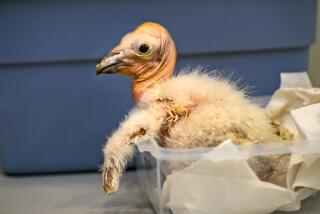Birth of ‘ghost cats’ a zoo coup
WASHINGTON — In the end, Hannibal did not administer the fatal bite to his mate’s neck. And Jao Chu did not immediately kill their offspring, as is often the case.
And so, early Tuesday, despite murderous tendencies in the captive species, two newborn clouded leopard cubs were found alive, well and squealing at the National Zoo’s Conservation and Research Center in Front Royal, Va.
They were taken from their gorgeous mother before she could do them harm, or do them in, placed in an incubator set at 88 degrees and fed salt water from baby bottles. Born with dappled, reptile-pattern fur, they were the first such births at the zoo in 16 years.
Their births were a coup, and the end of a complex reproduction saga involving an exotic and endangered species that experts call the ghost cat.
It was also a genetic home run: The zoo said the cubs’ genes, which come from outside the captive population, make them among the most valuable clouded leopards in North America.
“Genetically, they’re the most valuable animals outside their home range,” zoo expert Ken Lang explained, because their genes stem directly from the wild. “These are totally new genes.”
The births are a heavy responsibility. The precious cubs must be hand-raised by the zoo’s staff to guarantee their survival. “It’s scary,” said Lang, the center’s mammal unit supervisor. “It’s a lot of pressure. . . . We haven’t had babies for 16 years.”
In addition, the births were the first in the official North American clouded leopard zoo population in six years, the zoo said. The zoo has 14 clouded leopards, including the newborns -- two at the zoo in Washington and 12 at the research center, about 60 miles west.
The clouded leopard is native to Southeast Asia, the zoo said. It is about the size of a medium-weight dog, with a small head, luminous eyes and long, white whiskers. It has black and tan spots that seem to blur into one another, huge paws and an extremely long tail.
It is an acrobatic climber and can walk on the underside of tree branches or vertically down a tree trunk, the zoo said. And it has unusually long, sharp teeth that resemble the fangs on a poisonous snake.
But the leopards are endangered in the wild and are hunted in Asia for their pelts.
The zoo had a successful breeding program for clouded leopards during the 1980s and early 1990s, but it was halted in 1993 because of fears of inbreeding among related leopards across the country.
The program proved difficult to resume. The zoo’s animal reproduction expert, JoGayle Howard, said zoos across the United States and in Thailand found that when a male and a female were put together to breed, the larger male often would pounce on the female and kill her with a fatal bite to the back of the neck.
When a female did give birth, she often killed her cubs accidentally or intentionally, Howard said.
Experimentation eventually suggested that if a male and female were raised together, the male would not kill the female once they reached adulthood and mated, Howard said. “You want to put the male in with the female, pair them up as early as possible,” she said.
Hannibal and Jao Chu were such a pair. They were imported from Thailand last year, Howard said, and reached puberty together. Lang said experts believed the two mated several months ago at the center. About a week ago, curators realized Jao Chu looked as if she might be pregnant.
Several days ago, she was placed on a pregnancy watch, and when she turned down her usual snack of two dead mice Monday morning, Lang said they figured she was pregnant.
Early Tuesday, she vanished from the area of her enclosure that is monitored by video cameras, and about 1:30 a.m. Lang was summoned from his home on the center grounds. He unlocked the door of the leopard’s enclosure, entered and spotted her in the corner with the two cubs.
He left immediately.
“I didn’t want to get her upset,” he said. “First-time mother. You never know what they’re going to do with the babies.”
His reaction was excitement -- and fear.
“It’s excitement that she finally had them, and she really was pregnant,” he said. “And then it’s the fear: ‘Oh, my God, are they alive? Are we going to be able to get them out OK?’ And now, you’re the caregiver. . . . You become Mom.”
He said he was worried because the cubs were on a concrete floor and could become chilled. He wanted to get them into the incubator as soon as possible.
He said he gathered other curators and, armed with a net, three people reentered the enclosure, separated the mother, who backed off, and gathered up the cubs.
The cubs were taken to the center’s veterinary hospital, examined and found to be a little cold but in good health. One weighed 258 grams, the other 270 grams. Their sexes could not immediately be determined.
More to Read
Sign up for Essential California
The most important California stories and recommendations in your inbox every morning.
You may occasionally receive promotional content from the Los Angeles Times.










